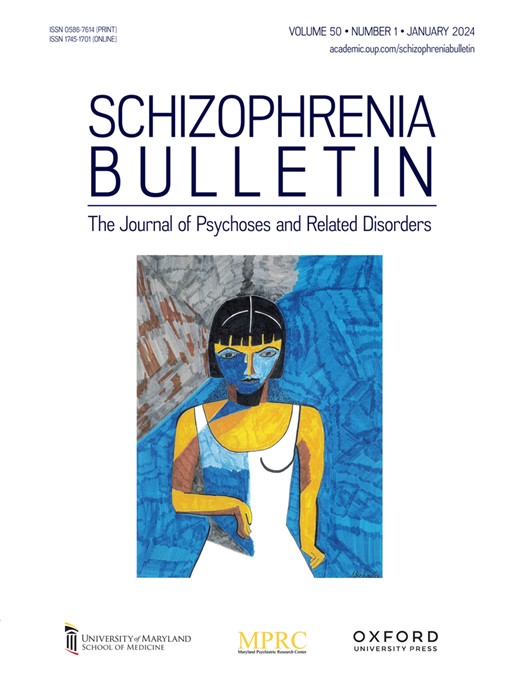减少氯氮平在缓解难治性精神分裂症患者中的剂量:一个病例系列
IF 4.8
1区 医学
Q1 PSYCHIATRY
引用次数: 0
摘要
背景氯氮平在缓解难治性精神分裂症(TRS)患者中的疗效证据有限。我们介绍了一系列缓解期TRS患者,他们接受了氯氮平维持剂量的逐步减少。研究设计:回顾性分析2014年3月20日至2024年3月20日在加拿大多伦多成瘾与心理健康中心接受氯氮平治疗的患者。我们纳入了符合TRS标准的患者,氯氮平缓解,并进行了渐进式减量。维持剂量的25%在纳入的9例病例中,4例(44.4%)在逐渐减少剂量后维持缓解。2例(22.2%)复发并住院,3例(33.3%)复发并需要增加氯氮平剂量。在复发的患者中,3例氯氮平低于治疗水平,1例在复发前停用氯氮平。总剂量减少范围从100%(完全停药并持续缓解)到25%(复发后再增加剂量)。氯氮平减少的平均速率缓慢,中位数为每12周25毫克。虽然没有统计学意义,但维持缓解的患者有较慢的减量率,从每5周25毫克到每2年25毫克不等。结论减少氯氮平维持剂量对缓解的TRS患者有很大的复发风险。当以氯氮平水平为指导,并在几个月到几年的时间内逐渐减少剂量时,风险可能会降低。需要更大的样本来确定接受氯氮平处方的TRS患者复发的预测因素。本文章由计算机程序翻译,如有差异,请以英文原文为准。
Clozapine Dose Reduction in Remitted Patients With Treatment-Resistant Schizophrenia: A Case Series
Background There is limited evidence on the outcomes of clozapine deprescribing in remitted treatment-resistant schizophrenia (TRS) patients. We present a series of TRS patients in remission who underwent progressive reductions in their maintenance clozapine dose. Study Design This was a retrospective chart review of patients treated with clozapine from March 20, 2014 to March 20, 2024, at the Centre for Addiction and Mental Health, Toronto, Canada. We included patients who met criteria for TRS, were in remission on clozapine, and underwent progressive reduction > 25% in their maintenance dose. Study Results Of the 9 cases included, 4 (44.4%) maintained remission following progressive dose reductions. Two patients (22.2%) relapsed and were hospitalized, while 3 (33.3%) relapsed and required an increase in clozapine dose. Of those who relapsed, 3 had subtherapeutic clozapine levels and one had stopped clozapine before relapse. Overall dose reductions ranged from 100% (complete discontinuation with sustained remission) to 25% (with subsequent dose increase after relapse). The average rate of clozapine reduction was slow across cases, with a median of 25 mg every 12 weeks. Although not statistically significant, patients who maintained remission had slower tapering rates, ranging from 25 mg every 5 weeks to 25 mg every 2 years. Conclusions Reducing the clozapine maintenance dose in remitted TRS patients carried a substantial risk of relapse. The risk may be lower when dose reductions are guided by clozapine levels and implemented gradually over several months to years. Larger samples are needed to identify predictors of relapse in TRS patients undergoing clozapine deprescribing.
求助全文
通过发布文献求助,成功后即可免费获取论文全文。
去求助
来源期刊

Schizophrenia Bulletin
医学-精神病学
CiteScore
11.40
自引率
6.10%
发文量
163
审稿时长
4-8 weeks
期刊介绍:
Schizophrenia Bulletin seeks to review recent developments and empirically based hypotheses regarding the etiology and treatment of schizophrenia. We view the field as broad and deep, and will publish new knowledge ranging from the molecular basis to social and cultural factors. We will give new emphasis to translational reports which simultaneously highlight basic neurobiological mechanisms and clinical manifestations. Some of the Bulletin content is invited as special features or manuscripts organized as a theme by special guest editors. Most pages of the Bulletin are devoted to unsolicited manuscripts of high quality that report original data or where we can provide a special venue for a major study or workshop report. Supplement issues are sometimes provided for manuscripts reporting from a recent conference.
 求助内容:
求助内容: 应助结果提醒方式:
应助结果提醒方式:


